The Fed recently implemented the first 0.75% rate rise since 1994 in an effort to curb soaring inflation.
Another 0.75% rise is expected at the central bank’s next meeting in July, in anticipation that inflation will not moderate accordingly to slow the pace of quantitative tightening.
By the end of the year officials expect the policy rate to rise above 3%.
With that in mind, Investment Strategy spoke to value managers from around the world for their take on what this means for portfolios.
Kelly Chung, investment director and head of multi-asset at Value Partners said the Fed was a “bit late” in tightening the policy, which made inflation out of control in the short-term.
Inflationary pressures were heightened with the increasing military tensions between Russia and Ukraine, pushing up energy and food prices further.
“Commodity prices will likely remain high in the second half of this year due to a possible escalation of the war between the two countries, implying that higher inflation will remain,” she said.
“With persistently high inflation and ongoing political risks, the overall economy is expected to fall into a recession.”
‘People’s emotions get the best of them’
Jonathan Boyar, principal advisor to the MAPFRE AM US Forgotten Value fund said he tries to filter out the macroeconomic noise when it comes to outlooks.
“Obviously, there are some genuine problems with inflation which we need to contend with. But as Buffet says, you pay a very high price in the stock market for a cheery consensus. So, I would look at your investments over three or five years to know if you are getting good, long-term value.”
He said it does not seem like we’re going into a deep recession, such as in 2007 or 2018.
“If someone takes more of a long-term perspective, it’s very difficult to do that in a market such as this, and when you’re losing all this money every day, people’s emotions get the best of them. So now is the time to think about adding and subtracting from your exposure.”
Alberto Matellan, chief economist at MAPFRE AM in Madrid added that the European Central Bank has three different enemies to fight at the same time.
The first he described as “the symptom” which is the evolution of spreads – so far not as alarming as in other moments.
“Second, the real sickness, which is the indebtedness and lack of growth of some European countries. This can be traced back to the origin of the European Union, but particularly to monetary policies carried out since 2010,” he said.
The third, he said, is inflation itself, which risks amplifying the two above.
“There is no obvious solution. Now from the comfortable position of looking at the rear-view mirror, it seems that the ECB measures devoted to support financial stability in the period of 2010-2021 might have been ill-advised.
“But it is equally true that such measures were designed to support the situation temporarily until a deeper solution came from the political arena.
“Although the above looks scary, we are still far from a fully-fledged blow up. The current consensus points to a moderation of inflation in late 2022 and a limit to ECB hikes in the range of 1.5%.”

